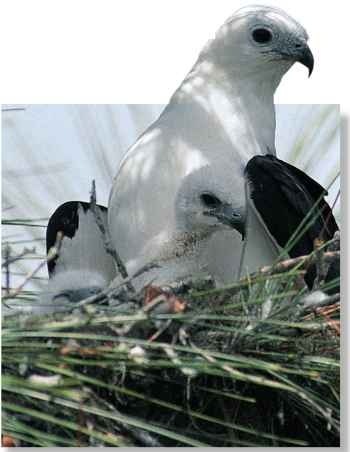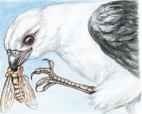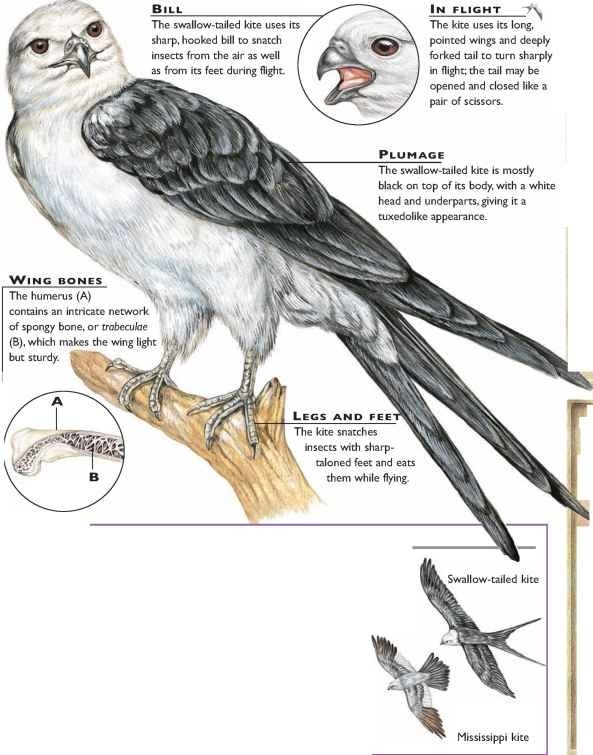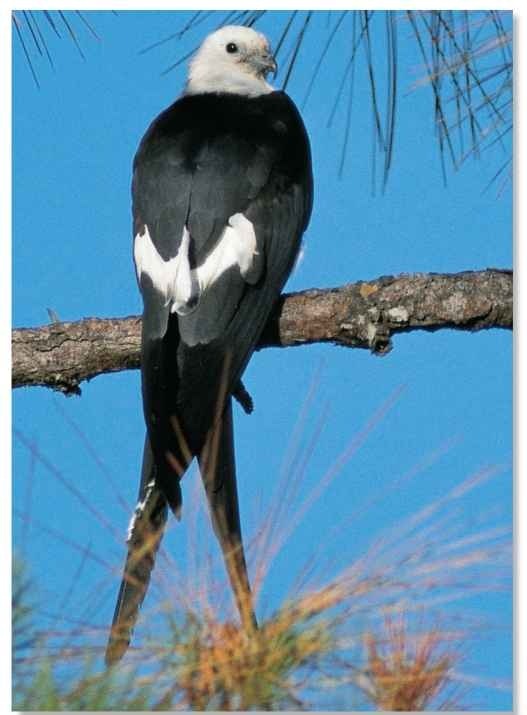ORDER
Falconiformes
FAMILY
Accipitridae
GENUS & SPECIES
KEY FEATURES
• Highly predatory, the swallow-tailed kite
often takes and eats insect prey in midair
• Snatches entire
nests of smaller birds and eats the young as it flies with the nest clutched in its extremely sharp talons
‘% Builds its nests at the very tops of the tallest trees in its habitat to avoid land predators
WHERE IN THE WORLD?
Found in the 1 southeastern U.S.; also in southwestern Mexico through Central America and in northern South 1 America to Argentina

Lifecycle
A migratory bird, the swallow-tailed kite spends only half the year in North America, usually arriving in March and leaving by September to winter in South America.
HABITAT
The swallow-tailed kite prefers the high trees and leafy expanses of open woods, swamps, bayous, marshes and hardwood forests. It frequents these areas in Mexico, Central America and much of South America. In North America, the kite is found in south Louisiana and south Texas, as well as in southwestern Florida, where large kite po-pulations inhabit the secluded mangrove swamps; there, they find plentiful swarms of flying insects to feast on and tall trees in which to nest.

A Classic combination
High trees near water and plenty of insects create the perfect habitat for the kite.
CONSERVATION
The swallow-tailed kite is not globally threatened. In fact, the bird is relatively common over much of its extensive distribution. However, in the U.S., where the bird formerly occurred in such northern states as Oklahoma, Minnesota and North Carolina, it now occurs only in southern states, such as Texas, Louisiana and Florida.The probable reason for this decline is habitat destruction for farming.
BREEDING
The swallow-tailed kite’s breeding season runs from January through June, depending on the region. Many kite nests are over 100′ from the ground, a height that makes studying the breeding behavior of this elusive bird a challenge. As part of its courtship behavior, the male kite has been observed feeding the female before copulation, which is frequent and noisy. The nest is constructed of twigs and lined with moss and situated on very small branches in the tops of high trees. These hard-to-reach areas make it harder for terrestrial animals to reach the nest — but they also make it vulnerable to birds of prey, such as the bald eagle and great horned owl. The female usually lays 1-2 eggs and incubation lasts from about 28-31 days; in two-egg clutches, the first egg is much larger than the second, and has a greater chance of survival. Both parents share parental duties; the male provides more food, but the female remains longer at the nest. Fledging occurs at about 40 days.

A Hiding place
Although both kite parents share in their parental duties, the female parent usually guards the nest while the male typically hunts for food.
BEHAVIOR
Gregarious swallow-tailed kites often nest quite close together in colonies, which offers an advantage in detecting and deterring potential predators. In fact, these groups of kites often launch cooperative assaults on larger birds of prey, such as bald eagles. The kite’s keen vision allows it to see attackers from far away and sound a high-pitched alarm call, eee or kee, repeated several times. Kite nestlings have been known to dribble excrement directly down onto the nest rim to avoid leaving telltale signs on the ground and attracting predators, especially raccoons, which abound in the kite’s Florida mangrove habitat.
As much as half of the entire population of American swallow-tailed kites congregate each year at central Florida’s Lake Okeechobee, apparently as a “staging area” before taking off for their annual winter migration to South America.
Though American swallow-tailed kites nest in the highest trees for safety from predators, these elevated structures are especially vulnerable to strong winds that whip through the treetops during Florida summers, destroying the nest and nestlings.
Protective pair
Kites often band together to drive away larger predators.

FOOD & HUNTING
The American swallow-tailed kite feeds mostly on insects grabbed in midair and snatched from the tree canopy during low, slow glides. It usually eats its catch on the wing, transferring the food from its strong, agile talons to its sharp, hooked beak while flying.
A typical kite dinner consists of numerous victims gleaned from a flying swarm of insects. The bird also preys on hummingbirds, which are caught by surprise as they hover while feeding on nectarTree frogs, anole lizards and snakes round out the bird’s diet. In Florida, where anole lizards are plentiful in the kite’s preferred mangrove forest habitat, they comprise 99% of prey delivered to the nest. The American swallow-tailed kite also takes young birds from their nests, often carrying off entire nests of smaller species and eating them with one leg free while clutching the nest with the other.

FLYING FOOD

1 Closing in
The swallow-tailed kite will use its sharp talons to snatch flying insects in midair

2 Dinner on the wing
The swallow-tailed kite usually passes its food from talon to bill while still in flight.

3 In for the kill
The swallow-tailed kite turns its agile tail to make sharp turns while chasing small prey.
4 Surprise attack
The kite extends its powerful legs to strike a nest and nestlings;it might carry both away.
Profile
American Swallow-tailed Kite
A skilled aerial hunter, the swallow-tailed kite can easily snatch elusive insects with its sharp talons, and eat them in midair.

CREATURE COMPARISONS
At 15″ in length, the Mississippi kite (Ictinia mississippiensis) is smaller than the swallow-tailed kite. While both birds inhabit parts of North, Central and South America, the Mississippi kite ranges farther north than the swallow-tailed kite. It frequents northern Texas, where it prefers open country and streamside thickets.The swallow-tailed kite, meanwhile, enjoys swamps and bayous in the southern U.S. Both birds spend about six months of each year in South America. Slender with pointed wings, the Mississippi kite is mainly gray though darker on the back and paler on the head. In contrast, the swallow-tailed kite is mostly black with a white head and underparts.
| VITAL STATISTICS Weight Length Wingspan |
11-18 oz. 20-25″ |
| 47-54″ | |
| Sexual Maturity | Up to 4 years |
| Breeding Season | Jan.-May; varies with region |
| Number of Eggs | 2-4 |
| Incubation Period | About 28 days |
| Fledging Period | 5-6 weeks |
| Breeding Interval | 1 per season |
| Typical Diet | Mainly large insects; also frogs, lizards, snakes and humming birds |
| Lifespan | Unknown |
RELATED SPECIES
• The American swallow-tailed kite is the only species in the small genus Elanoides. Joining the kite in the much larger order Falconiformes, however, are such birds as the golden eagle, Aquila chrysaetos, Cooper’s hawk, Accipter cooperii, the black vulture, Cathartes aura, the American kestrel, Falco sparverius and the peregrine falcon, Falco peregrinus.

